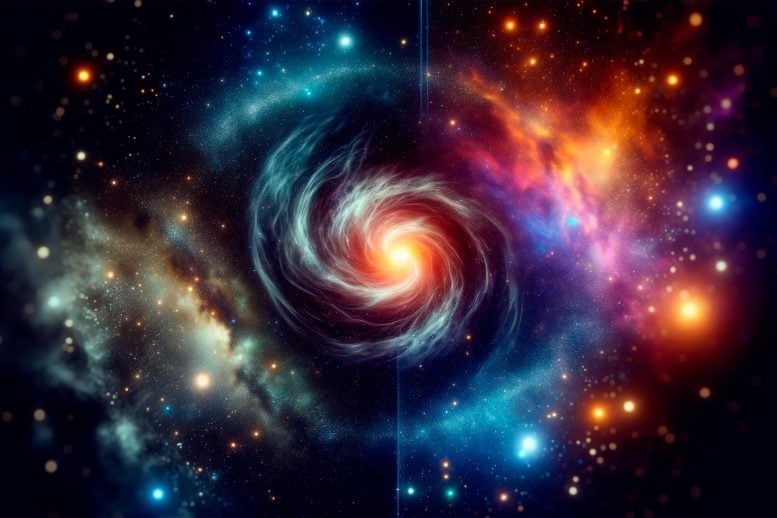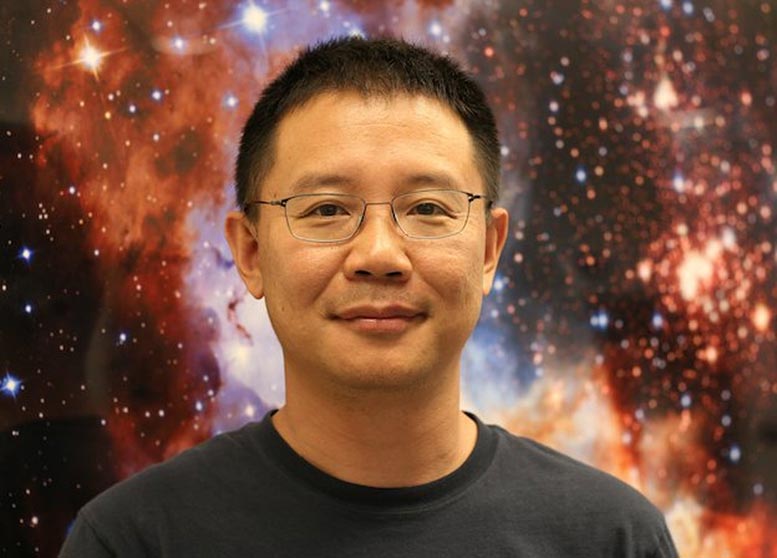
Researchers have advanced the understanding of dark matter through simulations supporting the self-interacting dark matter (SIDM) theory. This theory potentially resolves inconsistencies in dark matter densities observed in different galaxies, posing a challenge to the traditional cold dark matter (CDM) model and highlighting the dynamic nature of dark matter. Credit: SciTechDaily.com
Dark matter may be more vibrant than previously thought, UC Riverside study reports.
Thought to make up 85% of matter in the universe, dark matter is nonluminous and its nature is not well understood. While normal matter absorbs, reflects, and emits light, dark matter cannot be seen directly, making it harder to detect. A theory called “self-interacting dark matter,” or SIDM, proposes that dark matter particles self-interact through a dark force, strongly colliding with one another close to the center of a galaxy.
In work published in The Astrophysical Journal Letters, a research team led by Hai-Bo Yu, a professor of physics and astronomy at the University of California, Riverside, reports that SIDM simultaneously can explain two astrophysics puzzles in opposite extremes.
Understanding Dark Matter Halos and Gravitational Lensing
“The first is a high-density dark matter halo in a massive elliptical galaxy,” Yu said. “The halo was detected through observations of strong gravitational lensing, and its density is so high that it is extremely unlikely in the prevailing cold dark matter theory. The second is that dark matter halos of ultra-diffuse galaxies have extremely low densities and they are difficult to explain by the cold dark matter theory.”
A dark matter halo is the halo of invisible matter that permeates and surrounds a galaxy or a cluster of galaxies. Gravitational lensing takes place when light traveling across the universe from distant galaxies gets bent around massive objects. The cold dark matter, or CDM, paradigm/theory assumes dark matter particles are collisionless. As their name suggests, ultra-diffuse galaxies have extremely low luminosity and the distribution of their stars and gas is spread out.

Hai-Bo Yu is a theoretical physicist at UC Riverside with expertise in the particle properties of dark matter. Credit: Samantha Tieu
Yu was joined in the study by Ethan Nadler, a joint postdoctoral fellow at the Carnegie Observatories and University of Southern California, and Daneng Yang, a postdoctoral scholar at UCR.
To show SIDM can explain the two astrophysics puzzles, the team conducted the first high-resolution simulations of cosmic structure formation with strong dark matter self-interactions on relevant mass scales for the strong lensing halo and ultra-diffuse galaxies.
“These self-interactions lead to heat transfer in the halo, which diversifies the halo density in the central regions of galaxies,” Nadler said. “In other words, some halos have higher central densities, and others have lower central densities, compared to their CDM counterparts, with details depending on the cosmic evolution history and environment of individual halos.”
Challenging the CDM Paradigm and Future Research
According to the team, the two puzzles pose a formidable challenge to the standard CDM paradigm.
“CDM is challenged to explain these puzzles,” Yang said. “SIDM is arguably the compelling candidate to reconcile the two opposite extremes. No other explanations are available in the literature. Now there is an intriguing possibility that dark matter may be more complex and vibrant than we expected.”
The research also demonstrates the power of probing dark matter through astrophysical observations, with the tool of computer simulations of cosmic structure formation.
“We hope our work encourages more studies in this promising research area,” Yu said. “It will be a particularly timely development given the expected influx of data in the near future from astronomical observatories, including the James Webb Space Telescope and upcoming Rubin Observatory.”
Since around 2009, work by Yu and collaborators has helped popularize SIDM in the particle physics and astrophysics communities.
Reference: “A Self-interacting Dark Matter Solution to the Extreme Diversity of Low-mass Halo Properties” by Ethan O. Nadler, Daneng Yang and Hai-Bo Yu, 30 November 2023, The Astrophysical Journal Letters.
DOI: 10.3847/2041-8213/ad0e09
The research was supported by the John Templeton Foundation and the U.S. Department of Energy.









Could it be that what we term as black holes are actually dark matter stars and could these stars be the force causing ripples in spacetime which propagate the formation of the galaxies of visible that surround them? – just a thought!
Another sign that dragging Einstein gravity cult worship globalism all the way through the 21st century is not going to get any easier.
https://scitechdaily.com/the-universes-hidden-backbone-alma-unveils-dark-matters-fine-scale-fingerprint/
Focus, people! If a giant array of telescopes can focus on a galactic-scale effect generated by dipole waves of quantum gravity carriers that fail to worship Einstein’s gravity, then maybe so can you!
“Fingerprint” – I like that. It’s a picture of two overlapping fingerprints of “dark matter” effect, from two different galaxies, if you ask me. The point is the waves of “dark matter fingerprints” apparently show no signs of interacting at all, with the bonus of simultaneously also answering a question about whether dynamic gravity waves should interact to any significant extent. TMI for Cenobites!
This theory aligns with my thinking of dark matter and any attempt at positive natured detection will be futile until a sample can be drawn, we have gravitational lensing that produces a visual effect in a substantiation to the existence of dark matter but the probing of our instruments is based on electrically charged instrument workings. if dark matter is so inert totally void of a charge state only a sample would yield visual detection.
Genius over at Arse Tekknika: “Gravitons are massless, so they can’t be dark matter.”
Everyone worships Einstein over there, it’s like Yahoo, they can’t evolve beyond monopole gravitons so they’re hopelessly stuck, actors in a global farce, the pride of a nonexistent extradimensional universe has them all trapped under its thumb.
Feynman’s arguments against quantizing general relativity are persuasive because he uses logic. By his equally persuasive logic, the problem with gravitons in quantized general relativity is they must be monopoles (all pull or all push, never a combination).
Maybe the subscription to Ars-whatever (I looked up half the spelling just now, was working on faint impressions before) includes many other equally fine conde nast cosmetic fashion channels, like with Yahoo.
Biggest general relativity perpetuating quantum gravity clown move of all time is Maldacena’s supremely idiotic “holographic gravity.” It’s the solar system “rubber-sheet gravity well + bowling-ball sun” take on gravity, but fully dressed up in math. Take a flat gravity-free circular elastic slice of space, add gravity by putting a weight in the middle. The gravity well for a 2-D space needs a 3-D space carrying an extra dimension that is completely imaginary. If you can be convinced the extra dimension is not quantizable as it is an utterly nonexistent surface, you can be convinced quantized gravity is utterly nonexistent too.
“The holographic principle suggests that the contents of the universe … (are) encoded on a boundary surrounding the entire cosmos.”
In other words, all it takes to avoid quantizing gravity, and to simultaneously fix spacetime forever, is to first ignore the space part of it all. Dang, string theory makes it so easy to ignore gravity fields.
Why AdS space vacuum when Einstein specified dS space vacuum? The metrics in AdS space become longer as one moves toward the center of the space. The other thing with continuum spaces is one can suppose it’s all about differential equations and boundary conditions in order to never ever allow quantizability to creep in, ever.
Note that time, the least concrete and most subjective component of space-time, imo, is not considered, only space. That seems positive. It’s interesting to me because light-based clock tendencies and matter-based clock tendencies typically conflict, so wouldn’t it be nice if both tendencies were bent in the same way, inwardly increasing, for both satellites with mass as well as for falling photons? Lengths marked using a mass-based clock (or a *varying speed photon*) accelerating toward the center of a space, due to gravity, will duplicate the AdS metric spacing. Note that light clocks and matter clocks (gravity clocks) can only be compelled to track together by allowing “c” to increase in locations closer to matter. The suggestion is AdS space fits with having an increase in “c” for an observer in the center, while also providing a concrete basis for gravitational blue shifts commonly observed. Apparently this is relevant at typical quantum scales, but I see no nonpolitical reason it has to be limited to that.
There’s no need to suppose photons changing speed in a vacuum must decay if light energy and gravitational energy can be as freely exchanged, just as kinetic energy and gravitational energy are freely exchanged in the case of matter.
“The metrics in AdS space become longer as one moves toward the center of the space.”
One could call flattened AdS the “resting length space” of a standard spring component of a vacuum oscillator, which is nice since everything should be capable of oscillating in QM.
Best way to appear entangled is to always move in synchronism together. Best way to *build* entanglement, not just remaining to appear entangled, could be by never changing relative positions while maintaining identical spin orientations despite any distance. The idea is synchronism not only implies cooling (state concentrating) but also supports enhanced couplings with gravity and light. cold focus is the simplest and most realistic way to kill all less-than-worthless concepts of universal heat death.
Even experimental variations in “G” itself, not just in “g,” are supportable if the potential (monopolar) field gravity model is replaced with a vector (dipolar) field.
One may rely on variations in “c” with gravitational field intensity and allowing focused flows between cooled nucleons for all dynamic information-conveying non-locality, if there is any, it seems to me.
Holographic gravity boils down to a trick to handle the gravitational information flow problem that comes from avoiding quantized gravity fields. Einstein and Newton rely on gravitational energy modeled as a scalar, so the gravity field is essentially a “potential” energy field, like voltage or temperature. Voltage and temperature may look like they flow because they can vary, but Voltage and temperature cannot flow. All discreteness can be pushed on to the surfaces of black holes and on the boundary of the universe, supposedly, leaving space free to be a continuum, in theory. This seems to be the definition of imaginary universal heat death rather than a realistic way to avoid the inevitable need to quantize gravitational energy with flows realistic at a scale where hydrogen ions seem huge in comparison.
“These self-interactions lead to heat transfer in the halo, which diversifies the halo density in the central regions of galaxies,” Nadler said. “In other words, some halos have higher central densities, and others have lower central densities, compared to their CDM counterparts, with details depending on the cosmic evolution history and environment of individual halos.”
It’s the religion of “simulationism.” It’s a denial resembling seeking excessive plastic surgery. Very Hollywood-wormhole and scientology-like. It helps immensely to convince yourself you can simulate the formation of a grand design spiral galaxy from the BB, and waste hours of supercomputer time, but the spiral formation simulations proudly paraded around take far too long in universe time plus they look ridiculously sloppy and ephemeral to boot.
The loonies commenting on these articles are hilarious. “F****ed by gravity” or whatever is the funniest – word salad upon word salad of utter nonsense. I guess the janitor at JPL got access to the internet.